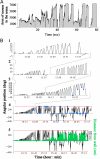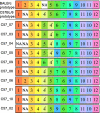Freedom of movement and the stability of its unfolding in free exploration of mice
- PMID: 19934049
- PMCID: PMC2795555
- DOI: 10.1073/pnas.0812513106
Freedom of movement and the stability of its unfolding in free exploration of mice
Abstract
Exploration is a central component of human and animal behavior that has been studied in rodents for almost a century. The measures used by neuroscientists to characterize full-blown exploration are limited in exposing the dynamics of the exploratory process, leaving the morphogenesis of its structure and meaning hidden. By unfettering exploration from constraints imposed by hunger, thirst, coercion, and the confines of small cage and short session, using advanced computational tools, we reveal its meaning in the operational world of the mouse. Exploration consists of reiterated roundtrips of increasing amplitude and freedom, involving an increase in the number of independent dimensions along which the mouse moves (macro degrees of freedom). This measurable gradient can serve as a standard reference scale for the developmental dynamics of some aspects of the mouse's emotional-cognitive state and for the study of the interface between behavior and the neurophysiologic and genetic processes mediating it.
Conflict of interest statement
The authors declare no conflict of interest.
Figures





References
-
- Olton DS, Collison C, Werz MA. Spatial memory and radial arm maze performance of rats. Learn Motiv. 1977;8:289–314.
-
- Hall CS. Emotional behavior in the rat: I. Defecation and urination as measures of individual differences in emotionality. J Comp Psychol. 1934;18:385–403.
-
- Eilam D, Golani I, Szechtman H. D2-agonist quinpirole induces perseveration of routes and hyperactivity but no perseveration of movements. Brain Res. 1989;490:255–267. - PubMed
-
- Horev G, Benjamini Y, Sakov A, Golani I. Estimating wall guidance and attraction in mouse free locomotor behavior. Genes Brain Behav. 2007;6:30–41. - PubMed
Publication types
MeSH terms
LinkOut - more resources
Full Text Sources

